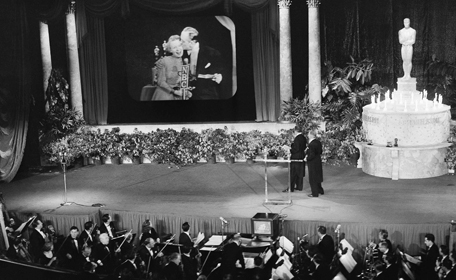On March 19, 1953, the Academy Awards appeared on television for the first time, and 34 million viewers tuned in.
Oscars Make Television Debut
NBC-TV’s broadcast of the 25th Annual Academy Awards featured ceremonies held in both Hollywood and New York City. Bob Hope hosted the main Oscars ceremony at Hollywood’s RKO Pantages Theater, while Conrad Nagel led a smaller ceremony at the NBC International Theater in Manhattan.
The six major categories—Best Picture, Director, Actor, Actress, Supporting Actor and Supporting Actress—featured winners from six different films, the first time in Oscar history this occurred. It has been repeated just twice, in 1956 and 2005.
Crowd-pleasing circus drama “The Greatest Show on Earth,” directed by 71-year-old cinema pioneer Cecil B. DeMille, won Best Picture over heavily favored “High Noon,” which featured Best Actor winner Gary Cooper.
Described by Time magazine as a “shotgun wedding between the 25-year-old Oscars ceremony and its child bride, television,” the broadcast cost NBC-TV’s parent company, the Radio Corporation of America, a monumental $250,000. The show attracted 34 million viewers.
Americans had been able to listen to the Oscars since 1930, when the second show was broadcast on radio. The first ceremony to be televised in color took place in 1966.
But not much has changed since Time magazine’s 1953 description of the scene on Oscars night outside the Hollywood RKO Theater: “klieg lights crisscrossing the wet night sky and Cadillacs disgorging jeweled cargoes.”
Read the original reviews of “The Greatest Show on Earth” by Variety, Time, and The New York Times.
Sources in this Story
- Academy of Motion Picture Arts and Sciences: History of the Academy Awards
- AMC: Filmsite: 1952 Academy Awards: Winners and History
- Time: The Oscars
The Oscars Through the Years
The first Academy Awards in 1929 gave special awards to Warner Bros. for the talking picture “The Jazz Singer,” and another to Charles Chaplin for directing, writing and starring in “The Circus.” The first ceremonies were dinner banquets, but the ever-expanding show was moved to theaters beginning with the 16th Oscar ceremony in 1944.
The number of categories for awards have steadily increased through the years. The first award for a foreign language motion picture was given to the Italian film “Shoe-Shine” in 1947, and Foreign Language Film became a regular award category in 1956.
In 1963, the Special Effects Award was split into the Sound Effects and Special Visual Effects categories. The Animated Feature Film Award became a category in 2001.
The Academy of Motion Picture Arts and Sciences provides awards information and data about award winners and ceremonies.











